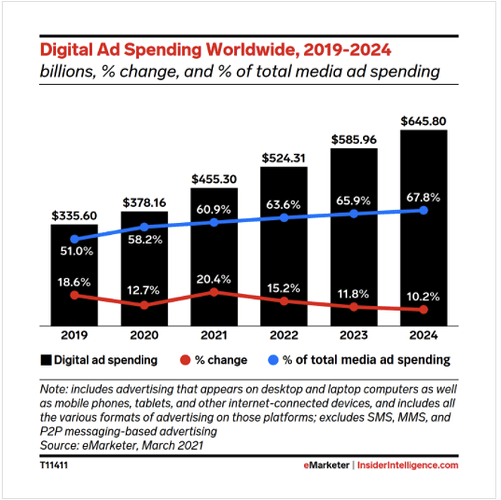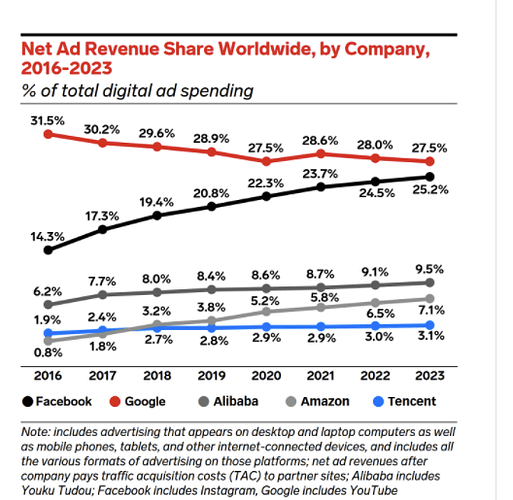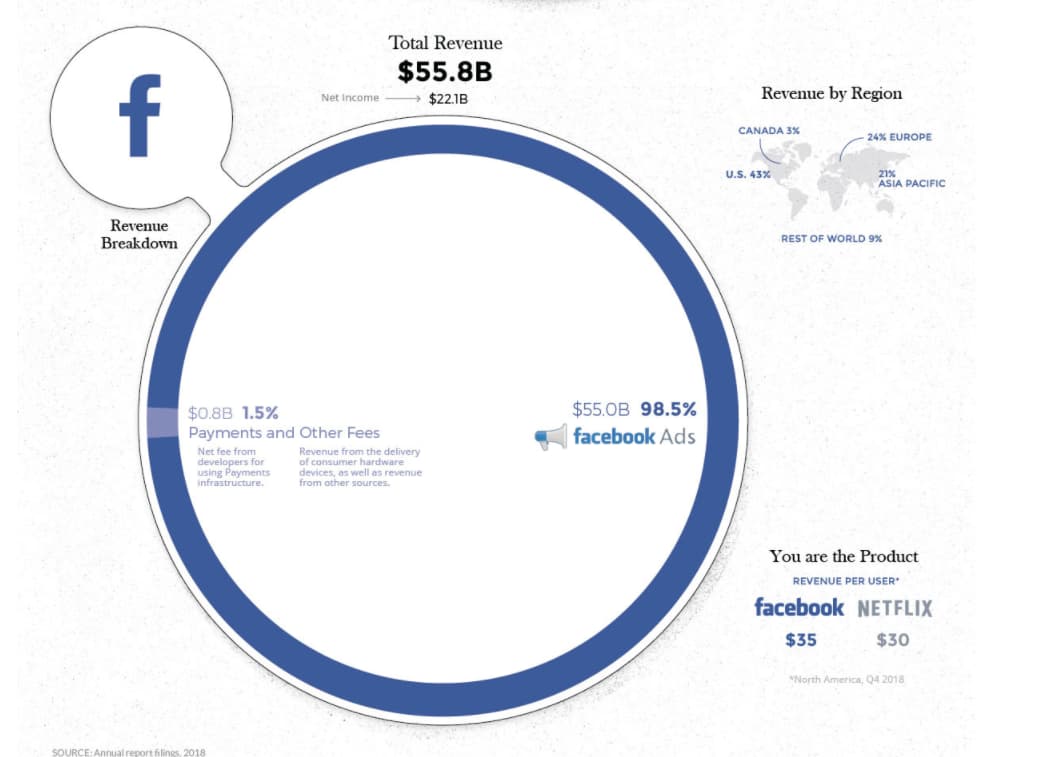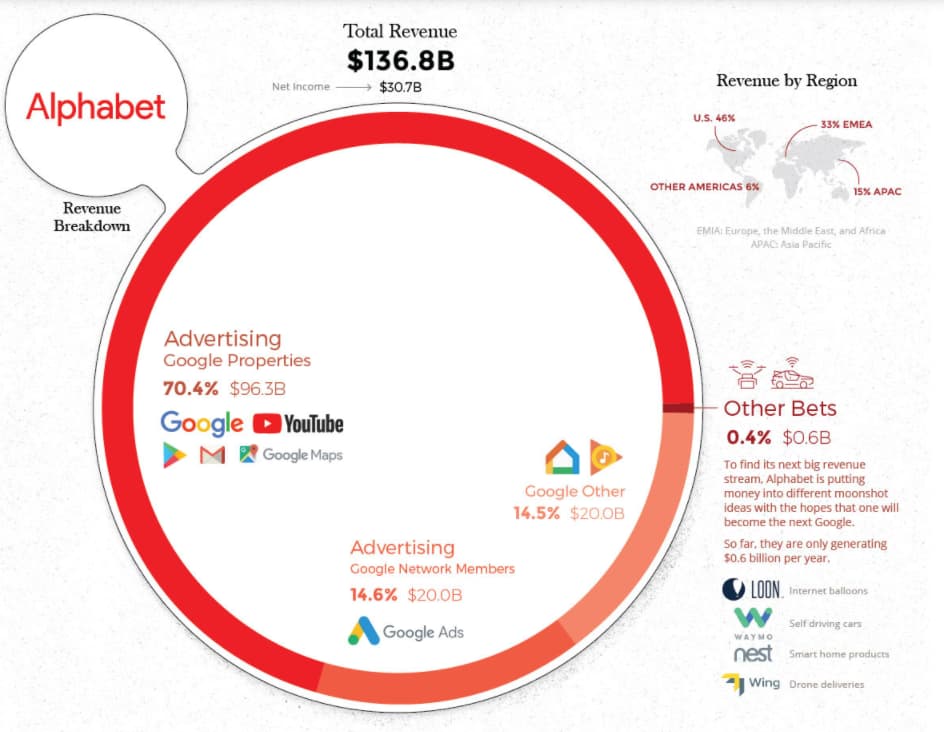Hello Friends and Family and welcome to tech with your hostest with the mostest, MeltedCrayon!
It has come to my attention that there are a lot of us who don’t know too much about the tech world other than Zuck looks weird, Myspace is dead and Tik Tok is for zoomers. Im here to de-mystify some stuff about tech and help you gain a better understanding of it.
This will be broken down in several ways:
-
Primer to the social space
-
The Players (focusing on Google and FB)
-
Digital Ads: Explained
-
Other factors - DAU, MDAU and a litany of other tech jargon thats important to know
-
Conclusion
Primer to the social space:
First and foremost, what you need to understand is that the vast majority of tech giants make their money through advertising. LIFE LESSON: IF A PRODUCT IS FREE, YOU ARE WHATS FOR SALE.
The global advertising industry is fucking massive. We will ignore all other facets of advertising (Print, Billboards, TV) and focus specifically on digital for the purposes of this conversation (duh). The beautiful thing about digital is that it’s growing, and it’s forecasted to continue to grow into the coming years. Bullish for companies like FB, Google, Twitter, Snap, etc, etc.
[center]
The Players
So now that you understand that digital advertising is quite large, lets take a look at how this landscape is divided up. For the purposes of this informational read, I will focus primarily on Google and Facebook as together they own about 50% of digital ad spend globally, with Amazon knocking on their doors. In the below infographic, you can see a breakdown of the top players in the digital ads space.
[center]
Dominated by Google (28.6% of spend in 2021) and Facebook (23.7% of spend in 2021). Youtube is wrapped up under Google, Instagram is wrapped up under FB, etc etc.
Digital Ads: Explained
Back in the day, you would need a full service agency Mad Men style to accomplish an ads campaign. Massive TV buys, ads in the news paper, etc. These days, you can get an even better ROI (return on investment) by leveraging the ads suite that is available from major tech platforms.
There are a multitude of buying methodologies that I could go into, but we would be here all day. The key is the simplicity. Google and FB have self-service ads platforms that you can dive into yourself, decreasing the barrier of entry and allowing for anyone to advertise on these major platforms. Because of the SCALE of their audiences, these ad campaigns are cheap and effective due to how much data these companies have.
For example, if you use instagram I know how old you are, where you live, if you’re male or female, your household income, your interests, what you have an affinity for based on what you engage with, etc. Its a marketers dream.
In the early days of digital - you could utilize one ad network (The Trade Desk is an example of this: TTD) to buy across multiple websites, if you want to be on AOL.com and ESPN.com you could leverage an ad network to do so. The way FB and Google established themselves as dominant is by becoming what’s known as walled gardens. The only way to acces the inventory on facebook and google was buy buying directly. They completely cut out the middle man and as a result their ads business exploded, fueling the tech craze.
The below infographic is from 2018 - but the dispersion of revenue is the same. Nearly 99% of FB’s revenue came from ads, nothing else. Im dropping this here JUST so you get an idea of how massive the ads world is for these specific companies.
Even Google, with a diversified product stream under the Alphabet umbrella, draws 85+% of its total revenues from ads.
OTHER FACTORS
So we’ve gone over ads revenue, so what else can you look out for in a tech earnings call? A lot actually!
How Users Are Tracked
So you’ve heard me mention IDFA - that refers to the unique identifier on your phone that allows you to link the data points that a property has on you to a unique user. For example, FB has no idea who I am - but they can tie my FB interests and Instagram interests to the same number (IDFA) and use that to create a profile thats then leveraged for ads.
Apple realized that this is intrusive, and allowed people to OPT OUT of sharing their IDFA with platforms. Using snapchat as an example, this is a bad thing as you can no longer leverage your audience data as you cannot tie it to a user. You have to resort to more contextual methods of targeting, putting ads in a place you expect users to be as opposed to following them around and put an ad where they are (example, putting a Ford ad on r/cars instead of somone seeing a Ford ad on r/Movies because they were browsing car stuff a while ago).
User Growth
Like all things, a product must continue to grow in order for people to have a bullish outlook on it. Acquiring new users will always be top of mind for tech companies - a tech company that misses its user acquistion goal may tank since its an implication that the business is becoming irrlevant, which will make people not want to advertise and lead to eventual revenue declines. It also implies that revenue will not go up as there are no net new users coming onto the platform - you’ve capped your audience. Nobody is going to be bullish on something thats dying (unless its GME or AMC).
Whats a DAU and why should I care
DAU stands for Daily Active Users and is an indication of a digital properties ability to monetize and scale their audiences. Its an indication of how many users are on their platform and how many ads can be served. Keep in mind, if you have 250mm DAUs that does not mean you can only serve 250mm ads as you one user might see 20+ ads in one browsing session. Its an indication, and you never want to see this number falling. If you do, see the previous paragraph.
There are other metrics that matter, like MAU (monthly active users) AADAU (ads addressable daily active users) - but thats passed the 101 calss that Im typing out now.
Conclusion
Net net, I hope this serves as a primer to the tech world to help you understand WHY giants like Google and FB are the size that they are. As we progress to a more online society, these giants are only going to get bigger. However, there is a saturation point - which is why we’re seeing companies like FB become META - they need to grow to survive. HOW they grow will be an indication of success.
And never forget, if something is free, you are whats for sale.



